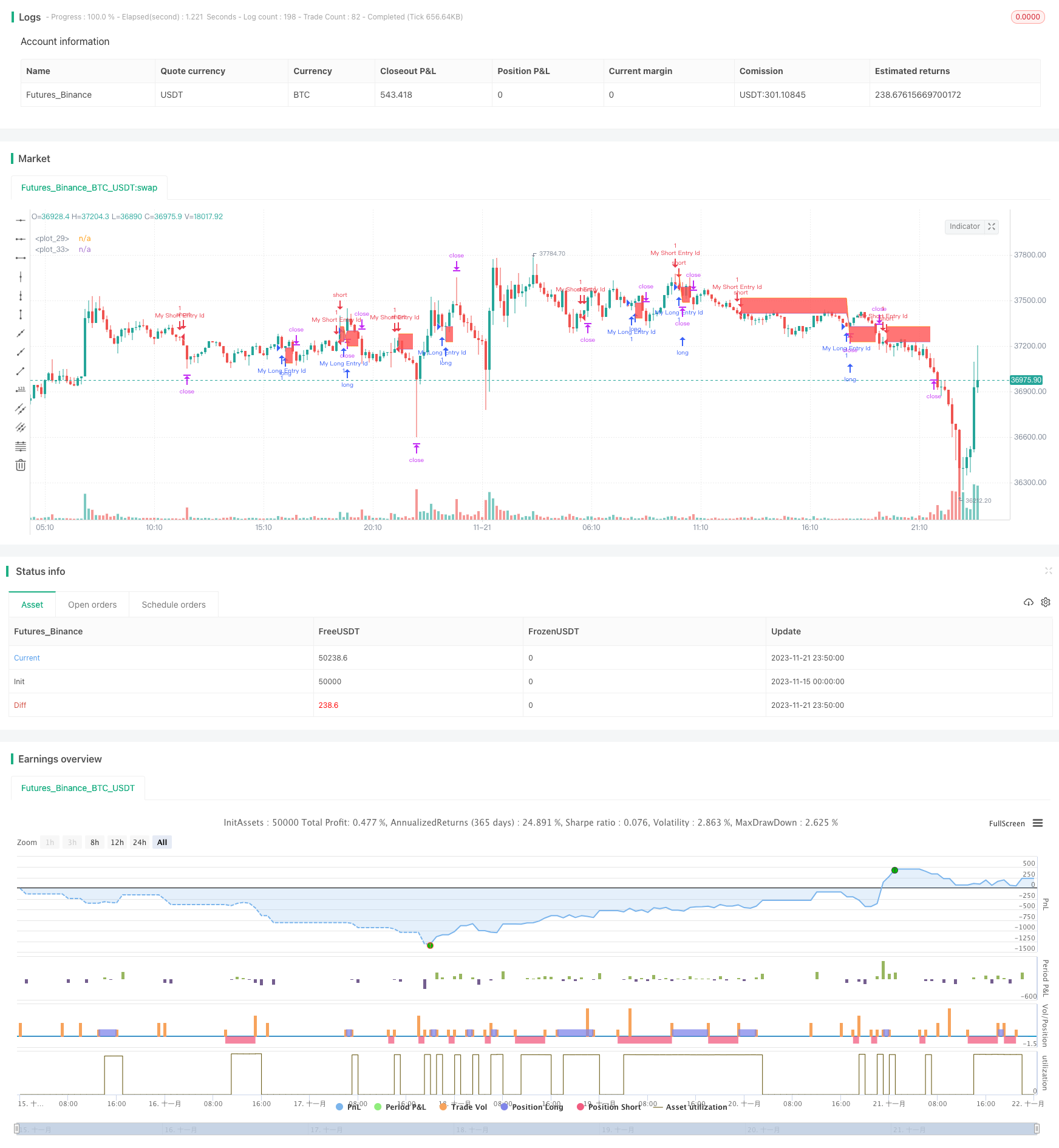
概述
本策略的核心思想是利用输入的止损止盈金额,来设置合理的止损止盈点数,对每笔交易进行风险和收益的管理。
策略原理
该策略首先设置了随机的入场信号,当SMA14上穿SMA28的时候做多,当SMA14下穿SMA28的时候做空。
在入场后,策略利用moneyToSLPoints函数,根据输入的止损金额,计算出对应的止损点数,同理也计算出止盈点数。这样就实现了基于美元金额的止损止盈设置。
例如,如果入场做多100手,每点值10美元,止损设置为100美元,那么止损点数就设置为100/10/100=0.1点。
最后用strategy.exit设置止损止盈出场点。同时画出止损线和止盈线的图形作为调试参考。
优势分析
这种基于价格止损止盈的策略,最大的优势是参数设置直观,可以直观的看到风险和收益的关系,进行参数选择。
另外,相对于点数止损,美元止损可以更好的控制实际的风险敞口。当市场波动加大的时候,美元止损可以更好的保护资金。
风险分析
这种止损止盈策略也存在一定风险:
止损点过宽容易被套。如果止损距离过远,行情短线反转的概率就比较大,很容易被套住无法止损。
止盈点过近难以获利。如果止盈距离太近,正常的单边行情都无法达到,很难盈利。
需要合理选择合约。如果选择的是点值太大的合约,例如原油,那么同样的美元止损,对应的点数就会很小,在市场波动中很容易被刮出。这就需要合理选择点值。
优化方向
这种策略可以从以下几个方面进行优化:
入场信号可以优化,例如结合趋势、波动率、季节性等选择更优入场时机。
可以根据不同品种,选择合适的止损止盈百分比。例如大宗商品可以设置更宽松的止损。
可以结合波动率,当波动加大时适当放宽止损;当波动减小时适当收紧止损。
可以根据交易日内不同时段选择不同的止损止盈策略。例如美国交易时段收紧止损,减少被套概率。
总结
本策略以美元金额为参数,实现了直观的止损止盈功能。该策略优势是参数选择和资金控制直观明了,缺点是容易被套和难以获利。我们可以从入场时机、止损止盈参数优化、合约选择等方面进行改进,使策略更稳定盈利。
/*backtest
start: 2023-11-15 00:00:00
end: 2023-11-22 00:00:00
period: 10m
basePeriod: 1m
exchanges: [{"eid":"Futures_Binance","currency":"BTC_USDT"}]
*/
// This source code is subject to the terms of the Mozilla Public License 2.0 at https://mozilla.org/MPL/2.0/
// © adolgov
// @description
//
//@version=4
strategy("Stop loss and Take Profit in $$ example", overlay=true)
// random entry condition
longCondition = crossover(sma(close, 14), sma(close, 28))
if (longCondition)
strategy.entry("My Long Entry Id", strategy.long)
shortCondition = crossunder(sma(close, 14), sma(close, 28))
if (shortCondition)
strategy.entry("My Short Entry Id", strategy.short)
moneyToSLPoints(money) =>
strategy.position_size !=0 ? (money / syminfo.pointvalue / abs(strategy.position_size)) / syminfo.mintick : na
p = moneyToSLPoints(input(200, title = "Take Profit $$"))
l = moneyToSLPoints(input(100, title = "Stop Loss $$"))
strategy.exit("x", profit = p, loss = l)
// debug plots for visualize SL & TP levels
pointsToPrice(pp) =>
na(pp) ? na : strategy.position_avg_price + pp * sign(strategy.position_size) * syminfo.mintick
pp = plot(pointsToPrice(p), style = plot.style_linebr )
lp = plot(pointsToPrice(-l), style = plot.style_linebr )
avg = plot( strategy.position_avg_price, style = plot.style_linebr )
fill(pp, avg, color = color.green)
fill(avg, lp, color = color.red)